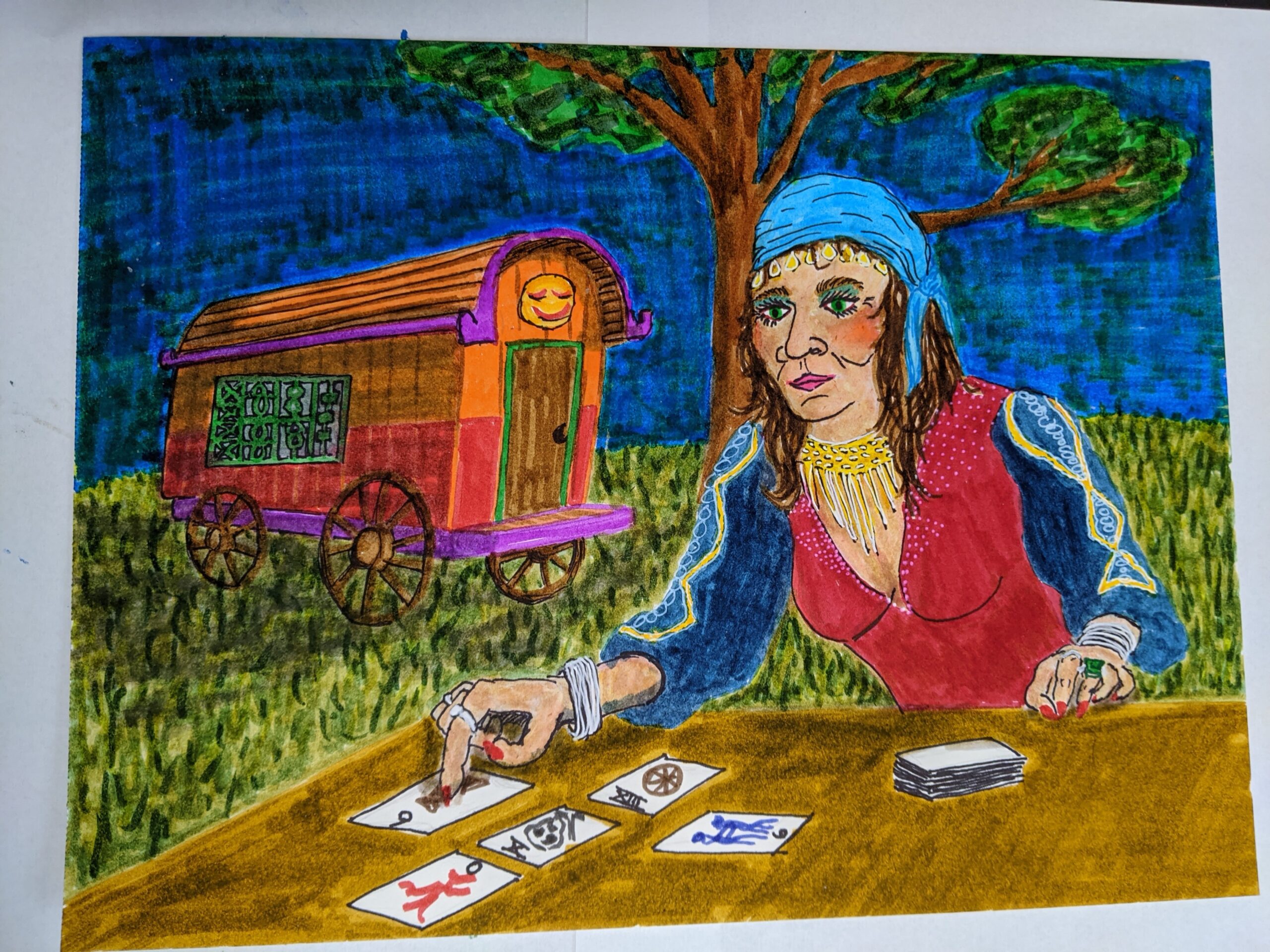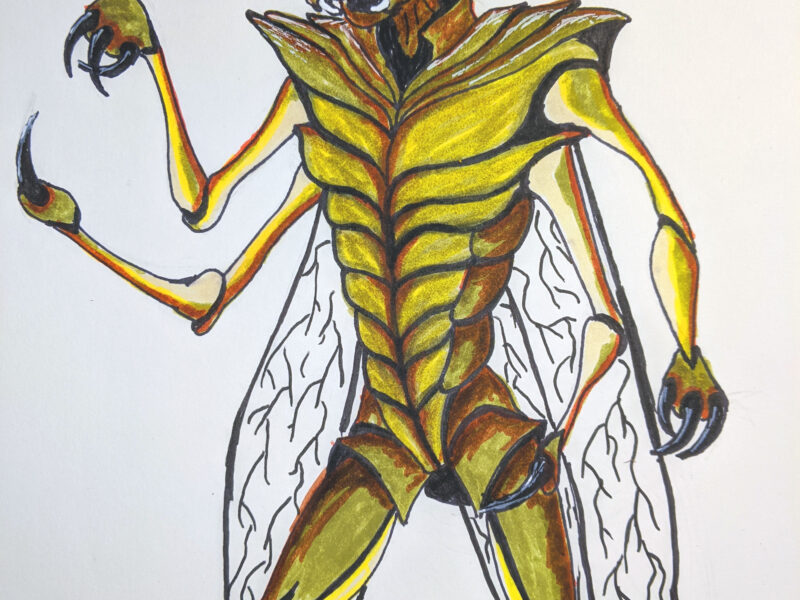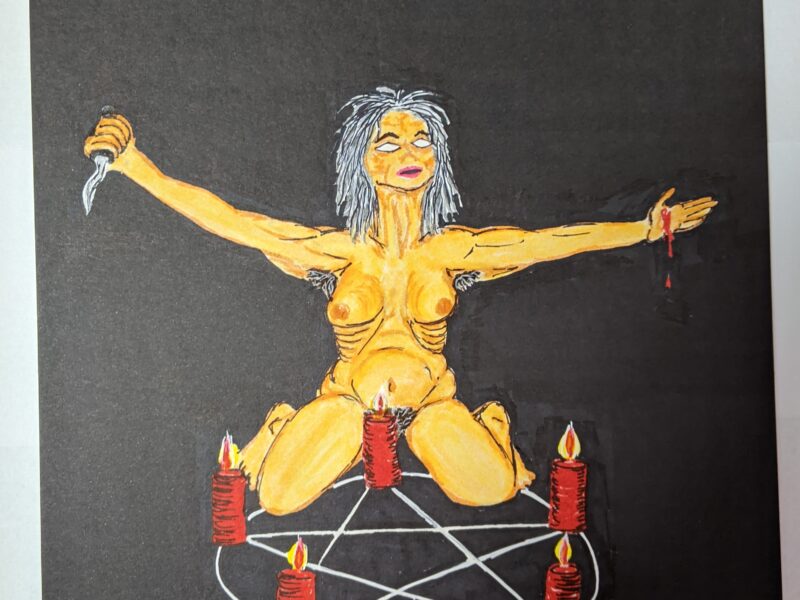This is another example of a drawing prompt gone well. I almost didn’t do it, because I don’t want to do tarot cards. Nothing against them…just not my wheelhouse. So when I decided to do the prompt, I went with a fortune telling scene. Its just brush pen work on bristol board but I like the way it turned out.
Here is some background on the subject of tarot cards, fortune telling and the Romani.
History of Fortune Telling:
Fortune telling, the practice of predicting information about a person’s life, has been present in various cultures throughout history. This art has taken many forms, each with its unique methodologies and cultural significance.
Ancient Practices:
- Mesopotamia and Egypt: Some of the earliest records of fortune telling come from ancient Mesopotamia and Egypt, where priests and oracles used astrology and other methods to predict the future.
- Greece and Rome: In ancient Greece and Rome, oracles, such as the Oracle of Delphi, and augurs, who interpreted the will of the gods by studying the flight of birds, were highly respected.
- China: In ancient China, fortune telling was an essential aspect of life, with methods like the I Ching (Book of Changes) providing guidance through hexagrams created by casting yarrow stalks or coins.
Middle Ages to Renaissance:
- Medieval Europe: During the Middle Ages, fortune telling faced opposition from the Christian Church, which saw it as heretical. Despite this, practices like astrology and the use of divination tools persisted.
- Renaissance Revival: The Renaissance period saw a resurgence in the popularity of occult practices, including fortune telling. Alchemy, astrology, and other forms of divination were studied and practiced by scholars and mystics.
Modern Era:
- 19th and 20th Centuries: The 19th century spiritualist movement brought renewed interest in fortune telling. Practices like palmistry, tarot reading, and crystal gazing became popular in Europe and North America.
- Present Day: Today, fortune telling is practiced worldwide in various forms, from traditional methods to modern adaptations, such as online readings and horoscopes.
Tarot Deck:
Origins and Development:
- Early History: The tarot deck originated in the mid-15th century in Europe, initially as a card game known as “tarocchi” in Italy. These early decks were used for entertainment rather than divination.
- Esoteric Use: The tarot’s use for divination began in the 18th century when occultists in France, such as Jean-Baptiste Alliette (Etteilla) and Antoine Court de Gébelin, started attributing mystical meanings to the cards. They linked the tarot to ancient Egyptian lore and the Kabbalah, although these connections lack historical evidence.
Structure of the Deck:
- Major Arcana: The tarot deck typically consists of 78 cards, divided into the Major Arcana and the Minor Arcana. The 22 Major Arcana cards represent significant life events and spiritual lessons, with iconic cards such as The Fool, The Magician, and The World.
- Minor Arcana: The 56 Minor Arcana cards are divided into four suits: Cups, Pentacles (or Coins), Swords, and Wands. Each suit contains numbered cards from Ace to Ten and four court cards: Page, Knight, Queen, and King.
Reading the Tarot:
- Spreads: Tarot readers use various spreads (arrangements of cards) to interpret the cards’ meanings. Common spreads include the three-card spread for past, present, and future, and the Celtic Cross spread for more detailed readings.
- Symbolism: Tarot reading involves interpreting the symbolism of the cards, which can include images, numbers, colors, and astrological associations. Readers often use their intuition and knowledge of the cards to provide guidance and insight.
Romani Tradition:
Historical Context:
- Romani People: The Romani, or Roma, are an ethnic group with origins in northern India, who migrated to Europe over a millennium ago. Throughout history, they have faced persecution and marginalization.
- Association with Fortune Telling: The Romani are often associated with fortune telling, a stereotype that emerged as they traveled across Europe. This association is both a reflection of and a response to their marginalization, as fortune telling became a viable means of livelihood for some Romani individuals.
Romani Fortune Telling Practices:
- Palmistry: Also known as chiromancy, palmistry involves interpreting the lines and features of the hand to predict the future and provide insight into a person’s character.
- Cartomancy: While the tarot deck is commonly associated with fortune telling, Romani fortune tellers have also used regular playing cards for divination, a practice known as cartomancy.
- Other Methods: Romani fortune tellers may also use crystal balls, tea leaves, or other traditional methods to provide readings.
Cultural Significance:
- Preservation of Tradition: For many Romani, fortune telling is not just a means of income but also a way to preserve and pass down cultural traditions and knowledge.
- Challenges and Stereotypes: While fortune telling is an important aspect of Romani culture for some, it has also contributed to harmful stereotypes and prejudice against the Romani people. Efforts to combat these stereotypes are ongoing, with a focus on highlighting the diversity and richness of Romani culture.
Conclusion: Fortune telling has a rich and varied history, evolving from ancient practices to modern interpretations. The tarot deck, with its intricate symbolism and structured design, remains a popular tool for divination. Within the Romani tradition, fortune telling holds cultural significance, serving both as a means of livelihood and as a way to maintain cultural identity. Understanding the history and context of these practices allows for a deeper appreciation of their complexity and enduring appeal.



